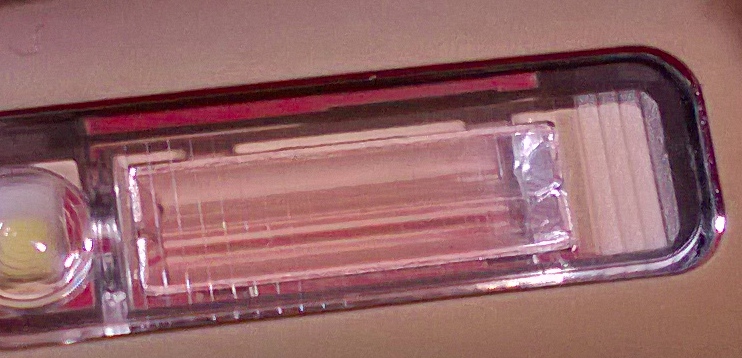Background and 'benefits'
As you'll know, I've been a massive proponent of Xenon flash in camera phones for years. The incredibly short flash duration (as short as 10 microseconds in some cases) and the extra brightness that comes from a Xenon discharge makes the flash system perfect for capturing motion in low light situations. Or, more exactly, stopping motion blur. Every person reading this will have tried taking LED-flash (or flash-less) photos ar parties with various phone cameras - you may get lucky and your main subject could be stationary (and your camera hand ditto, if your device doesn't have OIS), but 99% of the time you'll get something that might look OK-ish on the phone screen but which is, in reality, a blurry mess, as you'll see later on, on the desktop. Shutter time will be of the order of 1/30s at best.

The Xenon bulb on the Nokia 808, probably the most powerful flash ever put into a smartphone...
In contrast, with a flash time that's significantly less than 1ms, there's no time for either your camera hand or your subject to move significantly and you end up with wonderfully crisp photos, with subjects 'frozen' in time. All standalone cameras use Xenon flash and it's easy to see why.
The main reasons why camera phones have traditionally gone down the LED route are:
- cost
- possible bulk from the Xenon capacitor
- the need to have LED anyway, for torch functions
In addition, critics of Xenon flash in phones point out a few cons:
- there's a delay while the capacitor recharges (usually of the order of a second) and therefore it's possible to 'miss' a moment (e.g. a smile, a laugh, something cute!)
- the recharges use much more battery power than simply lighting up a LED
- Xenon-lit shots can, if you're not careful, light the subject so well that the background (and therefore context) becomes hard to make out
All of the above are true, plus on the Lumia 1020 there's an extra 'delay' factor, in that the oversampling of photos is done by the main processor and GPU and introduces an extra couple of seconds (at least) into the shot-to-shot times. Making it even easier to 'miss' the moment.
However, the benefits of Xenon, if you sidestep the worries above, can be tremendous. I've used these couple of examples before, but bear with me. Firstly an adult party (photo credit):

And secondly a toddler, at home:

The Art of Xenon
Getting the most from Xenon flash and two-to-four second shot-to-shot times (808 and 1020 respectively) does require some thought.
The fashion in the camera-toting smartphone world is very much for 'burst' mode capture, or at the very least taking shots very quickly indeed, the idea that one of them will be perfect. In fact, there's a healthy degree of trial and error in the Xenon world too - for every ten Xenon-list shots I might take at a party or event or family occasion, at least half, if not 80% will be unusable, usually because someone in question has been 'frozen' blinking or with a strange transitional expression or body attitude. However, two great shots out of 10 is a much better ratio than the typical two out of 100 that you'd get under similar conditions with LED flash or shooting 'flash-less'. I know, I've tried and tried with small relatives and their pets without Xenon available on various devices and have had a very frustrating time.
But what are the tricks of the trade when shooting with devices like the Nokia 808 and Lumia 1020? When you can't just shoot an all-lit burst of images and hope for the best? Why is it that I'm getting good results when others have, reputedly, tried and failed? How did I get shots like the one above?
1. Preparation
On both the 808 and 1020, you can be long pressing the physical shutter button while you're taking the phone out of its case or pocket. In either case, by the time you have the phone in position ready to take a shot, the (Nokia) Camera application will be fired up and ready to go. "Hold on while I start the camera app!" should be a phrase that never passes your lips!
2. Anticipation
Closely linked to no. 1 above and no. 3 below, part of your brain should always be thinking (in an event/family situation at least) of particular people and shots/frames you'd like to get. For example, a cute toddler wanders into the room and starts playing with a particular toy. They have their back to you, but you think "If they just turned round, still with the toy..." You can call their name, of course, but that tends to get an artifcial reaction ("Eh?") - if you're patient, you can just.... wait. Or perhaps a group of friends are standing together chatting but their faces are mainly away from you - try sneaking around the other side, or at least changing the angle in order to get a better shot.
In other words, think about what you'd like to get. But be aware that you may only get one or two shots at the photo. Toddlers have a habit of getting bored with a toy or outfit after a few seconds (really - "Angie, can you try this hat on? Aw, that's great. Oh, ok, never mind" - during which you had precisely two seconds to get the 'cute' shot!), while even adults have a habit of moving on, changing conversation partners or reckoning you've got the 'posed' shot you wanted and wandering off. So, you've got to be quick and make your one or two chances count.
3. Pre-focus
More than anything, this is the number one tip for capturing perfect 'moments', especially with kids. Look, if you're outside in sunlight, there's no issue, focussing will be near instant and you can even use Smart Camera (or other) burst modes and make sure the perfect moment is captured. Indoors or in low light, focussing takes a good fraction of a second and this is often the difference between catching a 'moment' and missing it altogether. Get impatient and snap before focussing is complete and you're bound to get an out of focus subject that's unusable.
The secret then, is to pre-focus. Being prepared (see no. 1) and having 'anticipated' (see no. 2) a particular photo or framing, pre-focus on something that's the right distance away (by half pressing the physical shutter key) - even a section of carpet will do if you're desperate - so that the optics are all set. Then, when the subject comes to the right spot or in the perfect attitude or there's that smile or laugh, you seal the deal by full depressing the shutter key the rest of the way.
This may all seem like overkill, but it's second nature after a while and this sort of on-the-fly thinking can get you shots that, in all probability, simply wouldn't be possible using LED flash or no flash at all.
PS. (for the Lumia 1020) There's actually a fourth thing to think about and plan for, in that while the Nokia 808's Camera and Xenon flash fire immediately, there's a tiny fraction of a second shutter delay on the 1020. Somewhere in the realm of a tenth of a second. Which means that, for true action shots, you might need to press the shutter key a tenth of a second before the specific moment you're after. The delay is very short and the impact slight, but it's something to bear in mind if you're trying to be very ambitious!

